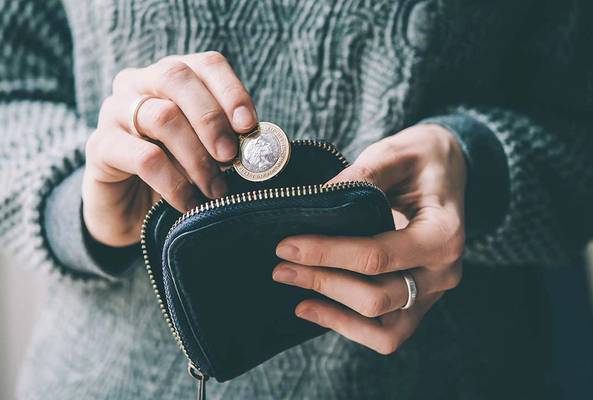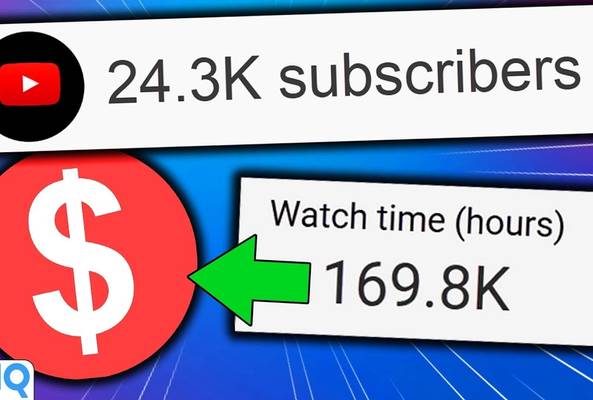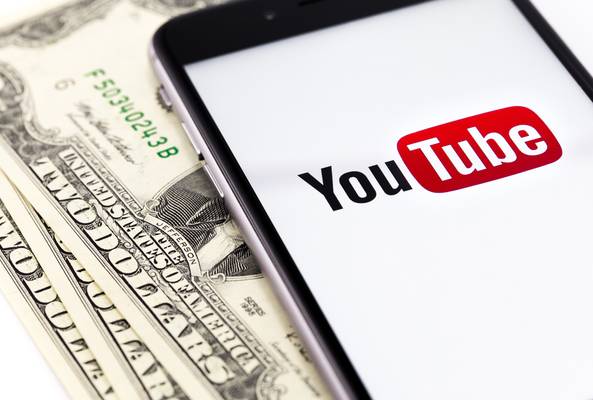Lydia Sweatt is a writer who loves balancing her article/blog time indoors with a healthy dose of nature. She bikes, hikes, and identifies edible plants along the way.
YouTube Shorts Monetization: How to Profit from Short Videos
As a short-form creator, you're probably wondering if you can monetize your YouTube Shorts like long-form creators monetize their videos.
The answer is yes! YouTube has several paths for monetizing short content, and this guide explains all of your options.
YouTube Shorts Monetization Requirements
One of the best ways to monetize your Shorts is through the YouTube Partner Program (YPP). Upon joining, you have access to all of YouTube's money-making tools, like the ability to place ads on videos or monetize your audience directly through fan-funding.
There are two ways to enter the YPP (you only need to choose one!).
To access fan-funding only:
- Gain 500 subscribers.
- Upload 3 public videos in the last 90 days.
- Get 3,000 public watch hours in the last 365 days or 3 million public Shorts views in the last 90 days.
To access ad revenue and fan-funding:
- Gain 1,000 subscribers.
- Get 4,000 public watch hours from long-form videos in the last 365 days or 10 million public Shorts views in the last 90 days.
If you mainly produce Shorts or a mix of long and short videos, aiming for 1,000 subscribers plus either 10 million Shorts views or 4,000 watch hours is a smart path to join the YPP.
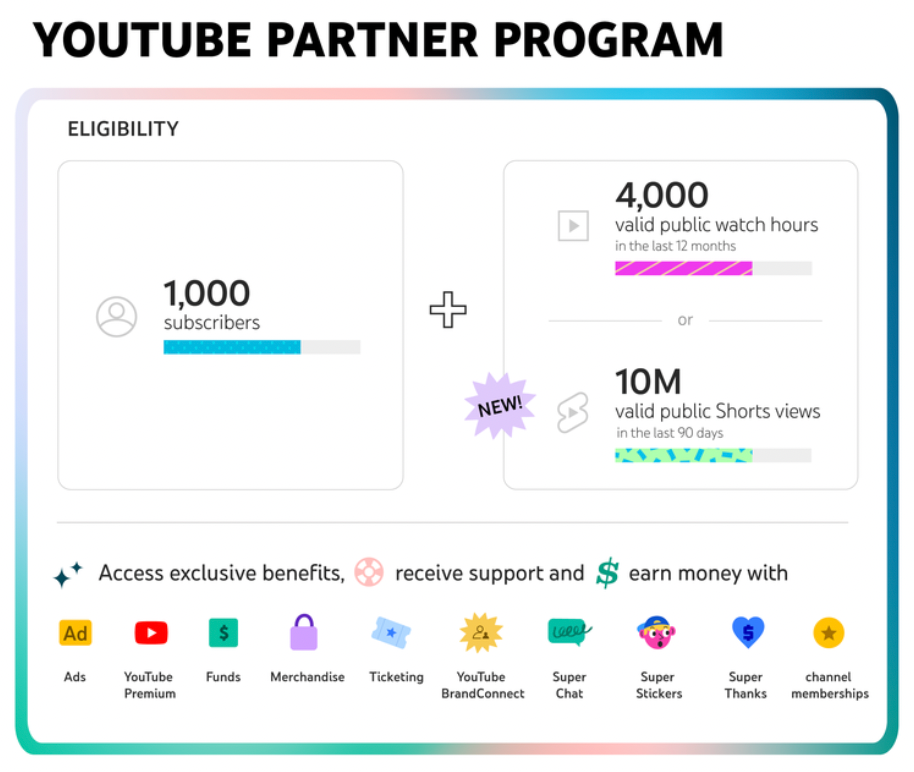
Image credit: Official YouTube Blog
Once you're in the program, only eligible Shorts will earn advertising revenue. So, do these four things to stay in the clear:
- Follow YouTube's Advertiser-Friendly Content Guidelines.
- Avoid using unedited clips from movies and TV shows that you don't have rights to.
- Avoid uploading another creator's content without adding a new perspective or transforming the content.
- Don't pay for automated/fake views.
Monetizing YouTube Shorts Through Ads: A Quick Rundown
Earning Shorts ad revenue is a bit different from monetizing a regular YouTube video. Notably, all Shorts revenue is split between different parties, including the creators who make them and the music publishers who provide songs for those videos.
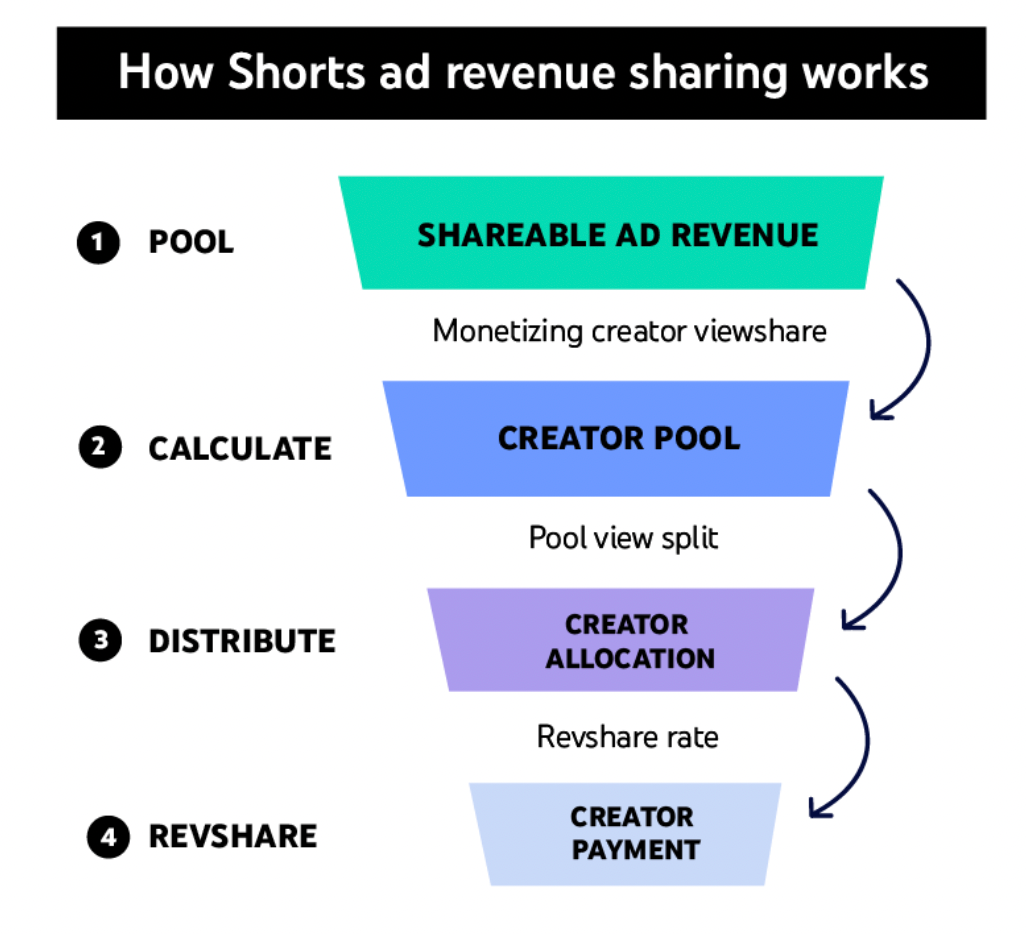
Image credit: YouTube Help center
Here is the 4-step process:
- YouTube pools all of the Shorts ad revenue on its platform.
- YouTube calculates how much money goes to the creator pool, which depends on views and music usage across all Shorts. If creators use no music in their Shorts, they retain all of the revenue at this point. If they use music, the revenue is split between the creator pool and music publishers.
- YouTube distributes the ad revenue to monetized Shorts creators. This is based on a creator's total share of Shorts views on the platform, whether that's 5%, 10%, 15%, etc.
- Creators keep 45% of their revenue share.
Can You Monetize YouTube Shorts Without 1,000 Subscribers?
If you're just starting out on YouTube, getting 500 subscribers is a quick way to join the YPP and monetize your Shorts. You won't earn ad revenue, but you can monetize most of your content — Shorts included — through fan-funding tools.
Earning Super Thanks
For example, with just 500 subs, you can collect Super Thanks revenue on your YouTube Shorts. These are "video tips" ranging from $2 to $50 that your fans can send to support individual videos.
Collecting Super Chats and Stickers
Super Chats and Stickers are an option as well, especially if you love streaming on YouTube.
When you host a vertical or horizontal live stream, viewers in the live chat can reward you with monetary donations ranging from $1 to $500. These can appear as Super Chats — colorful comments pinned to the top of the live chat — or as Super Stickers, which are fun, digital animations that appear on the screen.
Earning from Channel Memberships
Channel Memberships offer exclusive perks, such as members-only videos, badges, Community posts, emojis, and livestreams, to a creators' super fans. It's a great way to make money, but did you know that you can get your YouTube Shorts monetized through channel memberships?
After all, Shorts count as videos too! You can make these exclusive to your members just like regular, horizontal content.
How Much Money Will You Earn from Shorts?
Are YouTube Shorts monetized in a sustainable way? Can they become a side hustle or help you quit your day job?
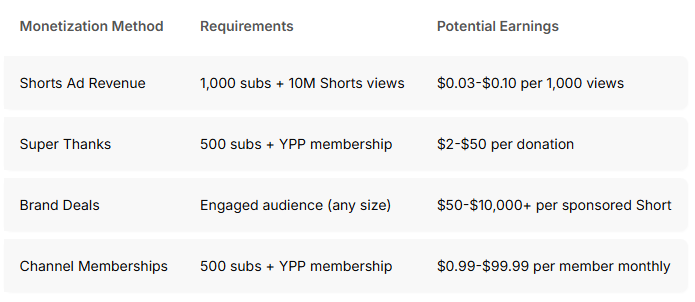
We'd have said it's hard to make decent money from Shorts only a year ago, barring times when you get a nice chunk of revenue. For example, we got $16.61 for a vidIQ Short that got 468,500 views.
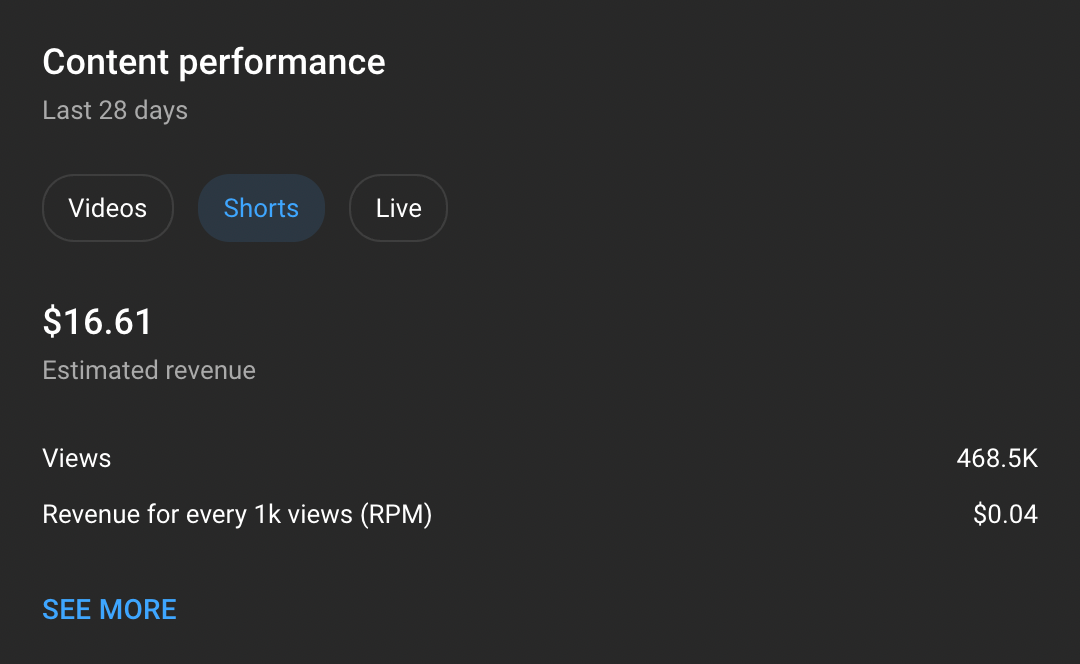
With recent updates on advertisements, RPM on our Shorts has seen an impressive 150% increase. So, for every 1000 views we are getting $0.10 revenue, without any external changes like location of viewers, topic of videos, etc.

This hasn't happened overnight. YouTube has steadily increased Shorts revenue on the vidIQ channel throughout the year. It seems like advertisers have finally found the sweet spot for their products in the Shorts ecosystem as other creators have also talked about experiencing similar surges on their channel. Watch Rob discuss all of that in the video below!
It's easier than ever to become a monetized Shorts creator, but you'll need YouTube Shorts ideas to call this a real side hustle!
Getting to Know the Shorts Monetization Module
If you want to earn from YouTube Shorts, start by approving the Shorts Monetization Module in your YouTube Studio. This agreement lets you earn money from ads and YouTube Premium in the Shorts Feed. Even if you’re part of the YouTube Partner Program, you won’t see any earnings from Shorts until you agree to these terms.
To set up Shorts monetization:
- Log in to YouTube Studio
- Click on Earn in the menu to the left
- Select Get Started for each available module
- Read and agree to the Base Terms and the Shorts Monetization Module
Keep in mind that views accumulated before accepting won’t earn revenue. Your earnings start only after you agree. This makes it a smart move to opt in as soon as you meet the requirements.
Brand Deals and Sponsorships
OK, so getting into the YPP to monetize your Shorts is a real challenge. You either have to go viral a lot or face the difficult task of earning 1,000 subscribers plus thousands of hours of watch time.
But guess what? You don’t have to join that race. There are other ways to make money from Shorts, and one of those golden opportunities is through brand sponsorships.
When a brand sponsors you, they’re paying you to advertise a product or service in one of your videos. That could be a new line of laptops, the latest leggings from Lululemon, or even a squeegee that removes pet hair from dirty carpet.
Here’s an example of a sponsored Short. In this video, actress Eliana Ghen advertises Vita, a mobile video editing app.
If you’re looking at this video and thinking, Hey, I could do that, you’re 100% correct.
Here’s why:
- You don’t need millions of views and subscribers to get a brand deal —just the right audience and a strong YouTube resume.
- 26% of marketers said they plan to invest in short-form content more than they did in 2024.
- Brands are excited to partner with short-form creators, who bring 2.5 times more engagement than long-form videos.
As for that last detail, don’t just take our word for it. Sponsorship coach Justin Moore echoes the same sentiment.
“At the end of the day, most brands don’t want to partner with you and feel like the only thing you’re good at is long-form video,” Moore says. “They want to feel that you may have some flexibility to create different types of content.”
Ready to get your first brand deal? Read this post to avoid the common mistakes YouTubers make while pitching brands.
Content Rules and Copyright Points
Not every Short qualifies for earning revenue. YouTube has clear rules on which videos can make money. For example, clips taken from movies or TV shows, repeated content from others, or compilations without any new spin won’t earn revenue.
Also, Shorts longer than one minute with claimed content are off the list for monetization. This is a key point if you plan to use material from other sources.
If your Short includes third-party material or is remixed, views could be shared with the rights owners when calculating revenue. As of now, only music content changes this share; other types do not affect it.
Keep your Shorts eligible by creating original work or by adding enough new elements and always following copyright guidelines.
Final Thoughts
There are a few mountains to climb when monetizing short-form content, but don't worry! You got this. Our blog has many tips and tricks to help you get 500 subscribers, 1,000 subscribers, 4,000 watch hours, and even 10 million Shorts views. Just click the hyperlinks throughout this post to get a winning plan for YouTube success!
FAQs
How to monetize YouTube Shorts?
You can monetize YouTube Shorts by joining the YouTube Partner Program and accessing the YouTube Shorts Fund, which rewards eligible creators.
Can you monetize YouTube Shorts?
Yes, you can monetize YouTube Shorts if you meet the eligibility criteria for the YouTube Partner Program and the Shorts Fund.
What are the requirements to monetize YouTube Shorts?
To earn money from Shorts using ads, you need 1,000 subscribers and either 10 million Shorts views in 90 days or 4,000 watch hours from long videos. For the fan-funding options, having 500 subscribers with 3 million Shorts views or 3,000 watch hours is enough.
How does YouTube Shorts monetization work?
YouTube gathers all ad revenue from Shorts and then uses a Creator Pool system to distribute the funds. Your share depends on your contribution to the total views, and you keep 45% of what’s allocated to you.
How much money can you make from YouTube Shorts?
Earnings vary, but many creators make between $0.03 and $0.10 per 1,000 views. For example, a Short with 1 million views might earn between $30 and $100. Rates are on the rise as advertisers invest more in short videos.
Can I monetize YouTube Shorts without 1,000 subscribers?
Yes, you can. With 500 subscribers, you gain access to fan-funding features like Super Thanks, Super Chats, and Channel Memberships. However, ad revenue only comes in after reaching 1,000 subscribers and the required watch hours.

